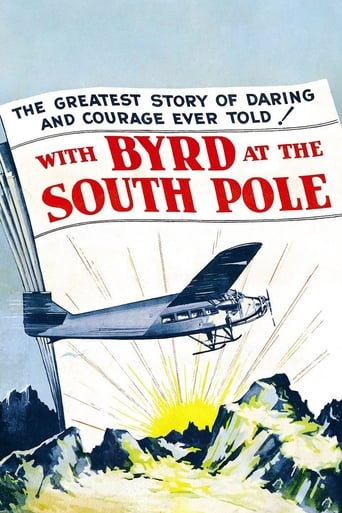bkoganbing
In the days of the high living Roaring 20s one of the heroes of the age was Admiral Richard E. Byrd. His two polar flights like Lindbergh's across the Atlantic stirred the adventurous spirit in us all. Unlike Lindbergh he never got the adverse publicity of questionable politics, nor suffered an overwhelming tragedy like the kidnapping of a son.Byrd, of the one of the oldest of American families, the Byrds of Virginia was in that order a naval officer and a scientist as well. The expedition to the South Pole and the establishment of the first Little America base was for science and exploration and not conquest. After a couple of centuries one of the more hopeful signs about mankind is that the occupation and exploration of Antarctica is being done cooperatively.Every expedition to the Antarctic had Byrd establishing a base camp that he named Little America. The last he was on established a permanent one. The one you see them constructing was a temporary shelter for the expedition members and was taken down and abandoned after the expedition left as were the others until the fifth and last one.This was the first documentary to win any kind of Oscar recognition and it was for cinematography. The shots of the men, the sled dogs and the penguins, whales, and seals and all interacting with each other were wonderful. But I suspect that the film got the recognition it did also for the sheer difficulty of filming in such a hostile environment. That usable footage came back at all was itself a miracle.Admiral Byrd and the men who went with them were some of the best and brightest in America at the time and real heroes. Glad we have this Oscar recognized chronicle of what they did.
Michael_Elliott
With Byrd at the South Pole (1930) *** (out of 4) This documentary picked up a Best Cinematography Oscar and rightfully so as some of the shots are just downright breathtaking. The documentary covers the year-long journey of Rear Admiral Richard Byrd as he tracks down to the South Pole where he attempts to become the first person to fly over it. The documentary picks up as the ship leaves New York and we pretty much see their not so good life for the next year as they struggle to build up their shelters as well as having to deal with the low temperatures and of course actually building the plane to try and make it fly. I think history buffs are certainly going to get a kick out of seeing this footage as there's no question that it's pretty remarkable getting to see this historic event. The cinematography really puts you right there as there are some terrific shots of the wildlife and some footage showing how dangerous everything is. Just take a look at some of the shots during the two blizzards that are shown and you're really amazed that no one was killed. There's also quite a bit of humor added in the title cards (the film is silent) in regards to the low temperatures and there's a funny sequence where we see some spring cleaning and we get to see how they get a hot bath. The Aeriel footage is another major plus. The film starts off with a talking sequence with Byrd delivering a speech about his journey. This is probably the worst sequence because of how badly he struggles to read the cue cards. His eyes are constantly looking over to the cards and even worse is how he has to break sentences up to look over and see where to pick up again. Still, the actual images is what makes this film so special and worth viewing.
lionel-libson-1
A few nights ago, my wife and I found ourselves talking about family problems at 3am. Sleep seemed impossible, so we went to the TV to find a more soothing mood. And there, on TCM, we found "With Byrd at the South Pole. Byrd stood nervously before the camera, stiffly, nervously trying to communicate the scope and dangers of his mission. The nervousness was in stark contrast to his absolute sure-handed, calm planning and control in the most trying circumstances.We marveled at the thoroughness and foresight of his planning, his concern for the safety of his crew--no one died on the mission, despite blizzards, crevasses, 4 straight months of no sunlight,and icy , treacherous footing, with temperatures reaching -72 F.Most outstanding was the Oscar-winning cinematography, unself-consciously artistic and breathtaking. We often wonder, watching adventure films, how cameramen somehow manage to be on a mountain peak before the climbers, wrestling heavy, awkward burdens of cameras, film and tripods. In this documentary, the visual thrills are endless and revelatory.One of the most interesting aspects of the film is the quiet dignity, humanity and willing work of the 42 trekkers. There is no evidence of complaining,a quiet competency and absolute dedication to hard work.There is a moving episode as a lead dog, overcomes illness and infirmity in a heartbreaking attempt to stay with the sled dog teams.This film is less "dramatic" than Flaherty's epics, but totally involving in terms of our emotional involvement.Find this film gem if you can...it's unforgettable.
tournier
A classic documentary in glorious black and white, the film is mostly silent, with a musical score added. There is a sound introduction by Byrd himself and a narrator describes the section showing the actual flight over the South Pole (though his narration is hurried). The film is beautifully photographed and won the Academy Award for cinematography in 1930. Helpfully, the print that I watched on Canadian TV was clear and crisp, making the film a visual treat to watch. I highly recommend this film over any newer versions of Byrd's story which would intercut the vintage film clips with modern material. This version gives a great feel for the immensity of the original expedition, with tidbits both momentous and minor.
